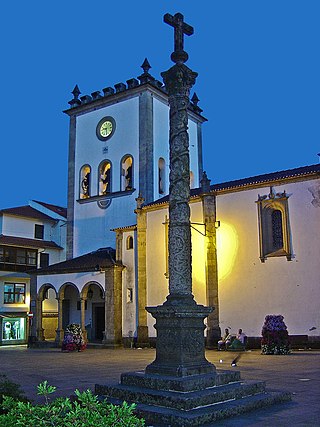Blue hour
Period of twilight in the morning or evening From Wikipedia, the free encyclopedia
The blue hour (from French l'heure bleue;[1][a] pronounced [lœʁ blø]) is the period of twilight (in the morning or evening, around the nautical stage) when the Sun is at a significant depth below the horizon. During this time, the remaining sunlight takes on a mostly blue shade. This shade differs from the colour of the sky on a clear day, which is caused by Rayleigh scattering.

The blue hour occurs when the Sun is far enough below the horizon so that the sunlight's blue wavelengths dominate due to the Chappuis absorption caused by ozone.[2] Since the term is colloquial, it lacks an official definition such as dawn, dusk, or the three stages of twilight. Rather, blue hour refers to the state of natural lighting that usually occurs around the nautical stage of the twilight period (at dawn or dusk).[3]
The blue hour is shorter in regions near the equator due to the sun rising and setting at steep angles. In places closer to the poles, the illumination and twilight periods are longer as the sun rises and sets at shallower angles.[4]
Explanation and times of occurrence
Summarize
Perspective
The still commonly presented incorrect explanation claims that Earth's post-sunset and pre-sunrise atmosphere solely receives and disperses the sun's shorter blue wavelengths and scatters the longer, reddish wavelengths to explain why the hue of this hour is so blue.[5] In fact, the blue hour occurs when the Sun is far enough below the horizon so that the sunlight's blue wavelengths dominate due to the Chappuis absorption caused by ozone.[2]
When the sky is clear, the blue hour can be a colourful spectacle, with the indirect sunlight tinting the sky yellow, orange, red, and blue. This effect is caused by the relative diffusibility of shorter wavelengths (bluer rays) of visible light versus the longer wavelengths (redder rays).[6] During the blue "hour", red light passes through space while blue light is scattered in the atmosphere, and thus reaches Earth's surface.
Blue hour usually lasts about 20–96 minutes right after sunset and right before sunrise. Time of year, location, and air quality all have an influence on the exact time of blue hour.[7] For instance in Egypt (every 21st of June), when sunset is at 7:59 PM: blue hour occurs from 7:59 PM to 9:35 PM. When sunrise is at 5:54 AM: blue hour occurs from 4:17 AM to 5:54 AM. Golden hour occurs from 5:54 AM to 6:28 AM and from 7:25 PM to 7:59 PM.
Art
- Die blaue Stunde (1890), painting by Max Klinger
- Sunset (1897), painting by António Cândido da Cunha
- Twilight (1897), painting by Edmund Tull (Ödön Tull)
- Taj-Mahal, twilight (1920), woodcut by Charles W. Bartlett
- Evening at the Lumber Yards of Kiba (1920), woodcut by Kawase Hasui
Photography
Many artists value this period for the quality of the soft light. Although the blue hour does not have an official definition, the blue color spectrum is most prominent when the Sun is between 4° and 8° below the horizon.[6]
Photographers use blue hour for the tranquil mood it sets. When photographing during blue hour it can be favourable to capture subjects that have artificial light sources, such as buildings, monuments, cityscapes, or bridges.
- The City of London during the blue hour
- Praia da Ursa, Cabo da Roca, Portugal. A wide-angle view of the seascape during the blue hour
- Zug, Switzerland during the blue hour
- Padmanabhaswami Temple of Kerala during the blue hour
See also
Notes
- A similar calque is used in many languages.[citation needed]
References
External links
Wikiwand - on
Seamless Wikipedia browsing. On steroids.









